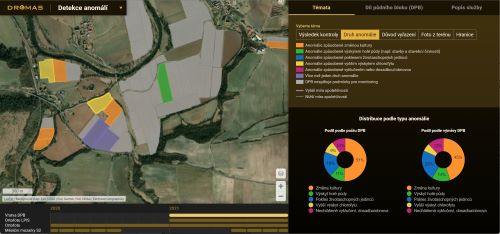
Farming is an increasingly challenging endeavour, with farmers not only having to respond to the needs of a growing population, but also to provide sustainable livelihoods for themselves and protect the environment. To address these challenges, the DROMAS Agricultural Crop Monitoring and Farming Management Service platform was developed by Czech company Gisat, under ESA’s Business Applications and Space Solutions (BASS) Programme. After successful implementation in the Czech Republic, the service is now poised to expand across Europe.
Agriculture today is about more than simply growing food; it’s about doing so efficiently and sustainably in the face of limited resources. The growing threats of climate change, soil erosion, and biodiversity loss have made farming more complex. As weather becomes more volatile and extreme events disrupt traditional growing seasons, crop productivity and economic profitability are increasingly challenged. New approaches and technologies can support farmers and the agricultural industry to adapt to these changing economic, ecological and social factors.
DROMAS leverages satellite technology to enhance the efficiency and sustainability of farming practices. DROMAS uses data and imagery from a range of satellites including ESA’s Sentinel-2 and Sentinel-1 to provide frequent and consistent detailed full crop monitoring country-wide. In addition, satellite navigation technologies enable targeted in-situ data collection.
The two state-of-the-art primary DROMAS services, Agricultural Crop Monitoring and Farming Management, provide farmers, agricultural advisors and national paying agencies with precise and actionable data to optimise farming practices and agricultural subsidy checks.
The DROMAS Agricultural Crop Monitoring service supports the operation of “Checks by Monitoring” implemented as part of the Area Monitoring System (AMS) within the Common Agricultural Policy (CAP). Ultimately the system supports subsidy controls and ensures compliance with environmentally sustainable farming practices. The service was implemented and demonstrated in close collaboration with the Czech State Agricultural Intervention Fund (SAIF) which manages and oversees national and EU subsidies.
The integration of space technology in agriculture reduces the need for labour-intensive field inspections, as satellite data allows authorities to identify issues such as non-compliance with CAP requirements remotely. This proactive approach not only lowers operational costs but also ensures the accuracy of parcels registered in the Land Parcel Information System, enhancing the overall efficiency of subsidy management and farming practices.

The DROMAS Farming Management service supports precision farming, a modern agricultural approach that optimises the use of resources such as water, fertilisers, and pesticides. By monitoring crop variability and providing data on crop vegetation status and plant health, DROMAS allows farmers to apply resources more accurately, reducing waste and increasing crop yields. This integration is further bolstered by a collaboration with CleverFarm, which contributes Internet of Things (IoT) monitoring services and farming consultations to improve crop management.
With its success in the Czech Republic, DROMAS is ready to be implemented across Europe and has already attracted interest from farmers and agricultural agencies in Slovakia.
“DROMAS can monitor vast areas of agricultural land quickly and accurately, saving time and reducing costs. We’re excited to see the positive impact it can have on the agricultural sector.” explains Davide Coppola, Head of Space Application Initiatives Section at ESA. “With innovations like DROMAS, the coupling of space technology and agriculture represents a significant step forward in addressing the critical challenges faced by farmers today; ensuring that farming remains profitable, sustainable, and environmentally responsible for generations to come.”
As DROMAS prepares for broader implementation, it is clear that satellite technology is set to play a central role in the future of agriculture. By providing accessible and affordable monitoring services, DROMAS ensures that farmers can adapt to economic, ecological, and social challenges, and ultimately contribute to a more sustainable and resilient agricultural sector.


